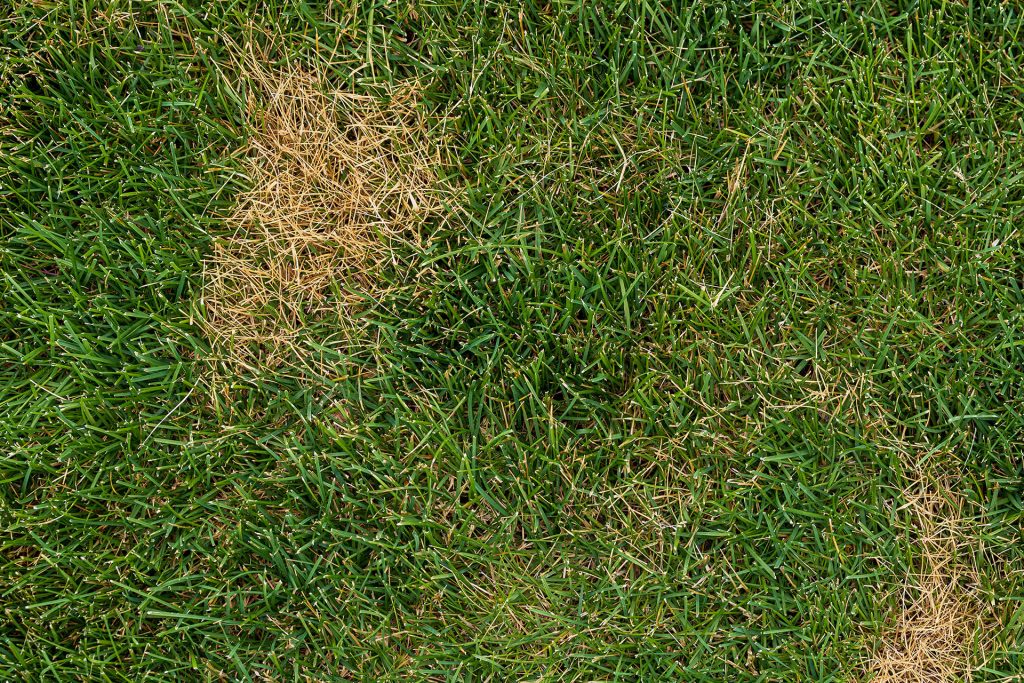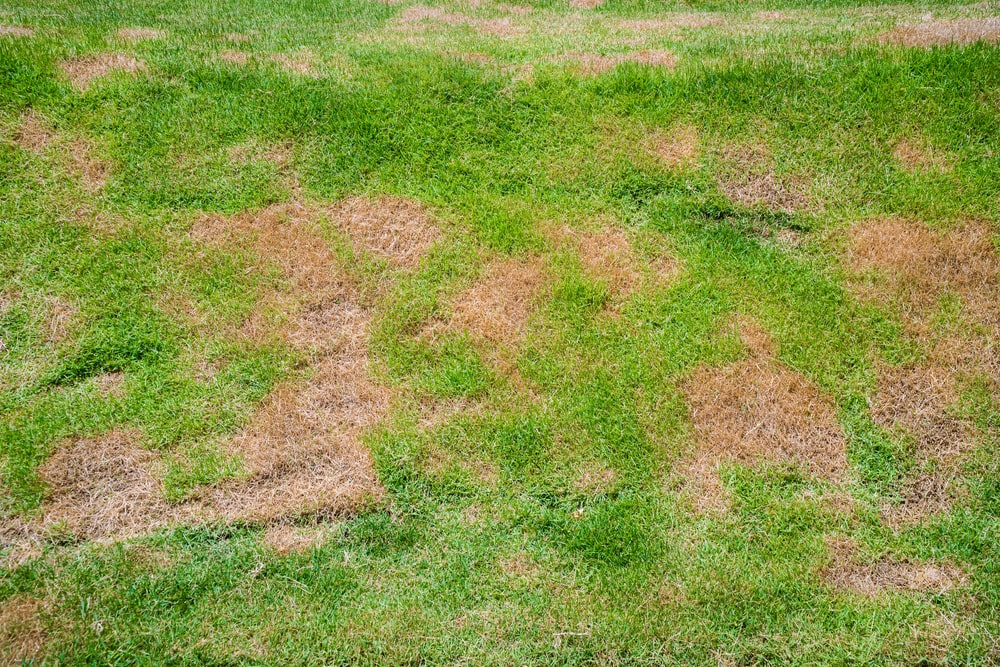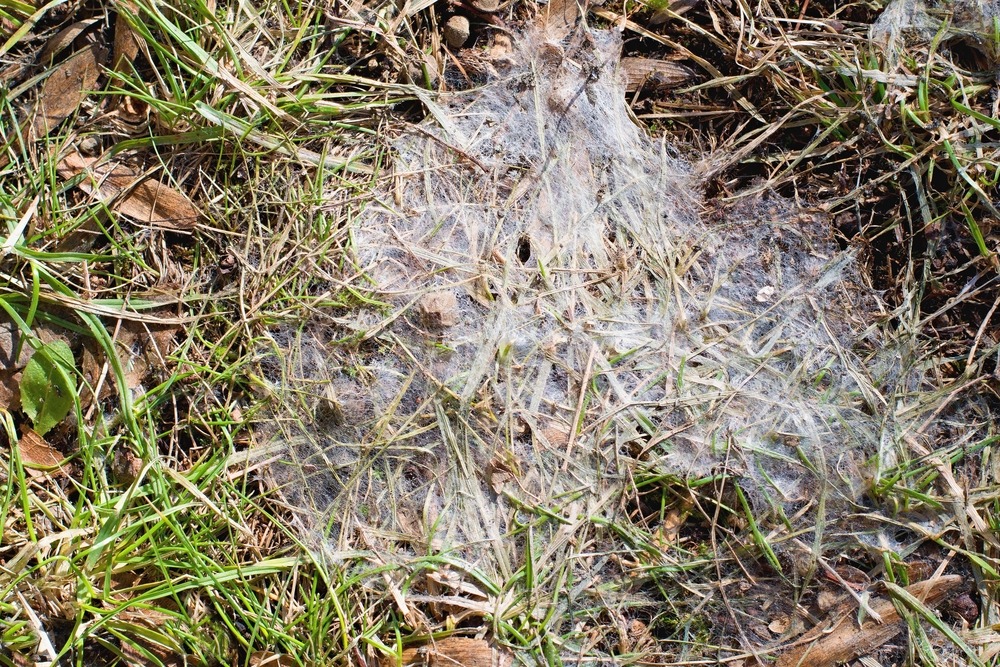
Any time you grow a large number of plants in close quarters, disease among the plants has a greater probability of occurring. And it can take hold before you have the opportunity to notice it. Contrary to popular belief, your lawn—yes, your lawn—can get sick. This can be a tough challenge because lawns are simply hundreds of the same grass plants right next to each other. In fact, many types of turfgrass disease can infiltrate your perfectly-green, summer-ready lawn. Even when you care for your lawn exceptionally well, the grass can still “catch a cold,” so to speak, in the form of discoloration or dead patches.
Disease fungi can fly through the air or tag along in soil, waiting to strike when the temperature is just right. Don’t be alarmed if you realize your lawn may be struggling with one of these all-too-common conditions. These problems are treatable. And they’re significantly easier to treat the earlier you can spot them. Below is all the information you need to know about Turfgrass disease, what you can do about it, how you can treat it, and how you can prevent it in the future.
What is turfgrass disease, and what are the most common diseases?
Turfgrass diseases can appear in many different forms on your lawn. It may show up as discoloration, patches, or mold growth. While turfgrass diseases are common and typically easy to treat, identifying the disease is an important first step. Here are the five most common turfgrass diseases:

Rhizoctonia solani
One of the most common and widely spread turfgrass diseases is brown patch or Rhizoctonia solani. This fungus can affect almost any lawn in many parts of the country. This disease can hit its peak when temperatures at night begin to linger between 65 and 70 degrees Fahrenheit in the early months of the summer season.
It is one of the easier diseases to identify due to the distinct brown patches, but it can creep up on your lawn unexpectedly. Usually, by the time it is a visually identifiable problem, it is relatively severe.
Large patch lawn disease
A similar affliction can also cause large dead patches on your lawn in cooler seasons. Although the pathogen’s route is the same in these two diseases, the symptoms are quite different. Large patches typically appear during spring or autumn, specifically in cool and moist weather. Patches generally begin forming as baseball-sized patches and can grow into areas larger than the size of a car. It is the primary disease of Bermudagrass and zoysiagrass in the transition zone. This common disease of warm-season turfgrasses is commonly referred to as ‘zoysia patch.
Pythium blight
Another common disease that can affect your lawn is Pythium blight. This is a foliar disease, and it can occur relatively quickly in newly planted turf. It is technically a water mold, and outbreaks can occur in lawns with inadequate drainage or in highly damp and humid conditions. Pythium blight shows up as small circles that appear on the grass, with a gray or water-soaked appearance.
Microdochium nivale
The fourth most common lawn disease is known as Pink Snow Mold or Microdochium nivale. Due to the word pink, one might expect that this is an easily identifiable lawn affliction. On the contrary, this pink mold is only a pinkish or reddish color for a small window of time and does not require snow to become a problem.
Regions with cool, humid weather can be affected by pink snow mold year-round. Symptoms of pink snow mold involve small round patches that can appear soaked and damp around the edges. In increasingly damp conditions, the edges of the patches can appear reddish or pink. Eventually, the patches can fade to a brown color when the weather dries out.

Gray snow mold (also called Typhula blight) is caused by Typhula spp., while pink snow mold (also called Fusarium patch) is caused by Microdochium nivalis.
Magnaporthe poae
Finally, one of the less common but equally significant lawn diseases is summer Patch or Magnaporthe poae. It can be one of the more difficult conditions to manage. This turfgrass disease typically makes its presence known through tan or brown circular patches during the late summer months.
However, this disease is particularly sneaky because it silently and invisibly damages your lawn during the spring and early summer, even though symptoms do not show until the end of the summer season.
Myths and Misconceptions
There are several myths and misconceptions about turfgrass disease. From how it spreads to how it’s treated and everything in between. Read on for some of the most common questions you need to know about turfgrass disease.
Can a lawnmower spread fungus?
Fungi can spread through wind, grass clippings, rain, and even a lawnmower. Your lawnmower can spread fungi around your property when they stick onto the mower blades or grass clippings. Lawn professionals will not mow a lawn affected by one of the above turf diseases because of this fact. Using an infected mower could dramatically spread this fungus to many other properties.
Walking across an affected lawn and then walking on a healthy lawn can also spread these diseases between locations. Sometimes lawn fungus is visible, and sometimes it is not, and the fungi only become truly noticeable once the disease is fully-fledged. Therefore, taking preventative measures to prevent spreading the disease is the key to ensuring you keep your lawn vibrant and healthy.
Will turfgrass fungus die in winter?
Fungi are more prevalent in the warmer summer months. This is particularly the case in the south, where lawns endure warm and consistently wet conditions such as high humidity. Often, homeowners who worry about fungus in the summer don’t realize that many of these prime conditions for fungal growth occur in the late fall, too. These problems go unnoticed throughout the winter months, only to reappear in the spring.
Many people emerge from the winter months wondering why their lawn is not getting as green and vibrant as it did just the year prior. Some may believe it was just due to the harsh winter months. However, the most common reason is that your lawn was infected by mold in the fall before falling dormant for the winter. And the cold temperatures in the winter do not kill fungi.
How do you get rid of turfgrass disease?
Luckily for homeowners, there are many ways to treat turfgrass and lawn disease. Fungicides can offer up to a month of protection against brown patch in addition to several other diseases that can occur on your lawn. Applying the proper fungicides in the fall or spring can help keep diseases from spreading slowly over time. Useful products to control lawn fungus include:
- Strobilurins
- SDHIs (penthiopyrad, etc.)
- Combination products containing strobilurins and DMIs (azoxystrobin + propiconazole)
Providing regular irrigation and lawn maintenance in damp and wet environments can also prevent water-based mold growth. Once symptoms appear, it becomes much harder to eradicate water-based molds with fungicides successfully.
It is best to take preventative measures against pink mold, especially. But there are ways to treat it once symptoms reveal their presence. Strobilurin and DMI fungicides are best when dealing with pink mold in particular and generally require multiple applications.
Can grass recover from fungus?
Finding out your lawn is afflicted with one of these turfgrass diseases is not necessarily a death sentence for your greenery. In fact, most of the time, your lawn will recover after treatment. Sometimes turfgrass disease can get deep into your lawn and soil, killing the entire grass plant. However, in most diseased lawns, the grass can recover in a matter of weeks. Watering, fertilizing, and mowing can also effectively prevent these problems from forming in the future.
Who can diagnose lawn problems?
After learning the signs of turfgrass diseases, anyone can notice a problem with their lawn. But it is best to approach a professional to figure out what specific fungus may be hurting your lawn. Purchasing a treatment on your own may not truly eradicate the problem. It may remove the problem momentarily, at best, but it is difficult to resolve the issue on a DIY basis.
How to prevent turfgrass disease
Not all of the same treatments work on every fungus. However, your best defense is a good offense. Thick, healthy grass is less prone to disease, and that starts with high-quality sod from The Turfgrass Group.
When you start with high-quality turfs like TifGrand Bermuda or JaMur Zoysia, you’ll be setting yourself up for success. These turfs are more resistant to disease, weeds, and insects than many popular alternatives. So when you’re ready to find a grower of the best turf, give us a shout!
Conclusion
In conclusion, maintaining a healthy lawn is not only about aesthetics but also about preventing and treating potential threats such as turfgrass diseases. Lawns, composed of numerous grass plants in close proximity, can fall victim to various diseases, leading to discoloration or dead patches. It’s crucial to recognize the signs early, as turfgrass diseases can be treated more effectively when identified promptly. This guide provides comprehensive information on common turfgrass diseases, their identification, and measures for treatment and prevention.
FAQs
What are the most common turfgrass diseases?
The five most common turfgrass diseases are Rhizoctonia solani (brown patch), Large patch lawn disease, Pythium blight, Microdochium nivale (Pink Snow Mold), and Magnaporthe poae (summer Patch).
Can a lawnmower spread fungus?
Yes, a lawnmower can spread fungi on your property, mainly if the mower blades or grass clippings carry the fungus. Lawn professionals avoid mowing affected lawns to prevent the spread of diseases, and homeowners should take preventive measures.
Will turfgrass fungus die in winter?
Fungi are more prevalent in warmer months, and cold temperatures in winter do not kill them. Some prime conditions for fungal growth occur in late fall, leading to issues that may go unnoticed until spring.
How do you get rid of turfgrass disease?
Fungicides, such as Strobilurins, SDHIs, and combination products, can protect against turfgrass diseases. Regular irrigation and lawn maintenance can also prevent water-based mold growth. Prevention is crucial, especially for diseases like pink mold.
Can grass recover from fungus?
In most cases, lawns can recover after treatment for turfgrass diseases. While some diseases can penetrate deeply, proper watering, fertilizing, and mowing can aid recovery and prevent future problems.
Who can diagnose lawn problems?
While anyone can recognize signs of turfgrass diseases, consulting a professional is advisable for accurate diagnosis and effective treatment. DIY solutions may provide temporary relief but may not fully resolve the issue.
How to prevent turfgrass disease?
The best defense against turfgrass diseases is maintaining thick, healthy grass. Starting with high-quality sod, such as TifGrand Bermuda or JaMur Zoysia from The Turfgrass Group, can set the foundation for a disease-resistant lawn.
